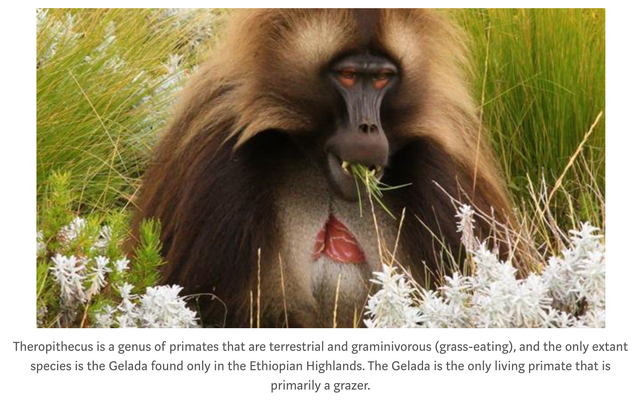Pliopapio alemui (Frost, 2001) shows morphology that is intermediate between that of more terrestrial forms, such as extant Papio and Theropithecus, and more arboreal forms, such as extant colobines, and can be found in the fossil record at 5.7 million years ago in Asa koma (predicted to be an ancestral form), and 4.4 million years ago in Aramis.
There is a trend in the fossil record in Afar that leaf-eaters (folivores) adapt to become grass-eaters (graminivores), the grazing horse dates back to Afar and is descended from Miocene "forest horses" that ate leaves, browsers, and Paranthropus deyiremeda is descendant genetically from the Gorilla lineage, that speciated from the interbreeding event 6 Ma (that also caused the speciation of Australopithecus), and is a grass-eater that is descended (by introgression) from folivores.

The similarities between Pliopapio alemui and colobines (Grine, F. E., 2011), the "leaf-eating monkeys" branch of the Cercopithecids, and Cercopithecines like the grass-eating Geladas that are alive today, could stem from that they are an intermediary form, that has begun to adapt to the coastal grassland on Danakil, isolated from the Ethiopian main land by the Sea of Afar, and whose descendants Papio and Theropithecus then followed the Homo lineage as they migrated out from Afar and brought grasslands along with them by using fire from volcanoes around Lake Turkana to manipulate their environment, like their descendants still do today.

Synapses
Grine, F. E. (2011). Ardipithecus kadabba: Late Miocene Evidence from the Middle Awash, Ethiopia. The Middle Awash Series, Volume 2. Edited by Yohannes Haile‐Selassie and Giday WoldeGabriel. Berkeley (California): University of California. ISBN: 978‐0‐520‐25440‐4. 2009. The Quarterly Review of Biology, 86(2), 125–126. https://doi.org/10.1086/659893
Frost, S. R. (2001). New Early Pliocene Cercopithecidae (Mammalia: Primates) from Aramis, Middle Awash Valley, Ethiopia. American Museum Novitates, 3350, 1–36. https://doi.org/10.1206/0003-0082(2001)350<0001:nepcmp>2.0.co;2
Bernor, R. L., Gilbert, H., Semprebon, G. M., Simpson, S., & Semaw, S. (2013). Eurygnathohippus woldegabrieli, sp. nov. (Perissodactyla, Mammalia), from the middle Pliocene of Aramis, Ethiopia. Journal of Vertebrate Paleontology, 33(6), 1472–1485. https://doi.org/10.1080/02724634.2013.829741
Popadin, K., Gunbin, K., Peshkin, L., Annis, S., Fleischmann, Z., Kraytsberg, G., … Khrapko, K. (2017, May 9). Mitochondrial pseudogenes suggest repeated inter-species hybridization in hominid evolution. Cold Spring Harbor Laboratory. https://doi.org/10.1101/134502
Scally, A., Dutheil, J. Y., Hillier, L. W., Jordan, G. E., Goodhead, I., Herrero, J., … Durbin, R. (2012). Insights into hominid evolution from the gorilla genome sequence. Nature, 483(7388), 169–175. https://doi.org/10.1038/nature10842
Haile-Selassie, Y., Gibert, L., Melillo, S. M., Ryan, T. M., Alene, M., Deino, A., … Saylor, B. Z. (2015). New species from Ethiopia further expands Middle Pliocene hominin diversity. Nature, 521(7553), 483–488. https://doi.org/10.1038/nature14448
Congratulations @johan-nygren! You have completed the following achievement on Steemit and have been rewarded with new badge(s) :
Click on the badge to view your Board of Honor.
If you no longer want to receive notifications, reply to this comment with the word
STOPTo support your work, I also upvoted your post!
Downvoting a post can decrease pending rewards and make it less visible. Common reasons:
Submit